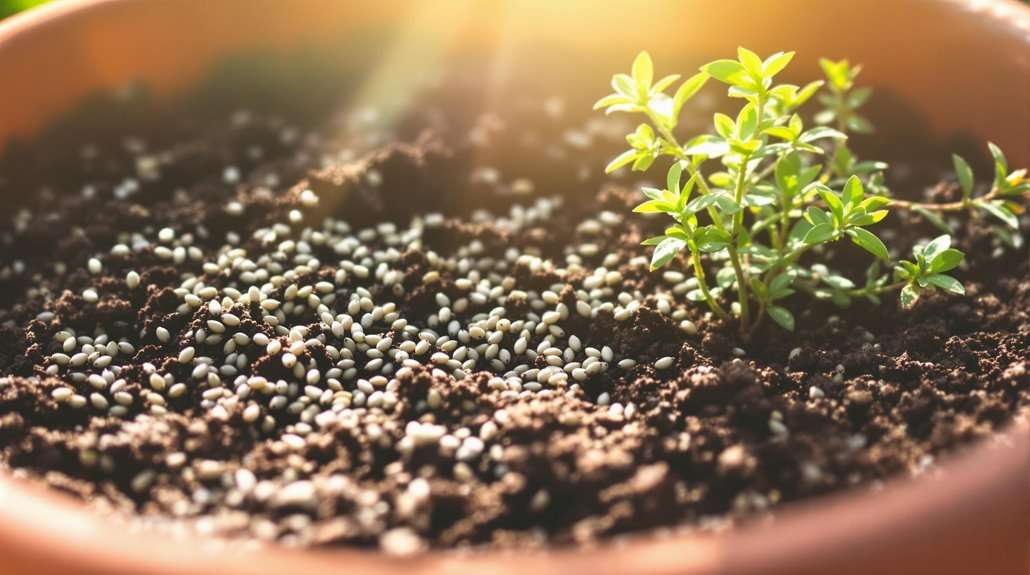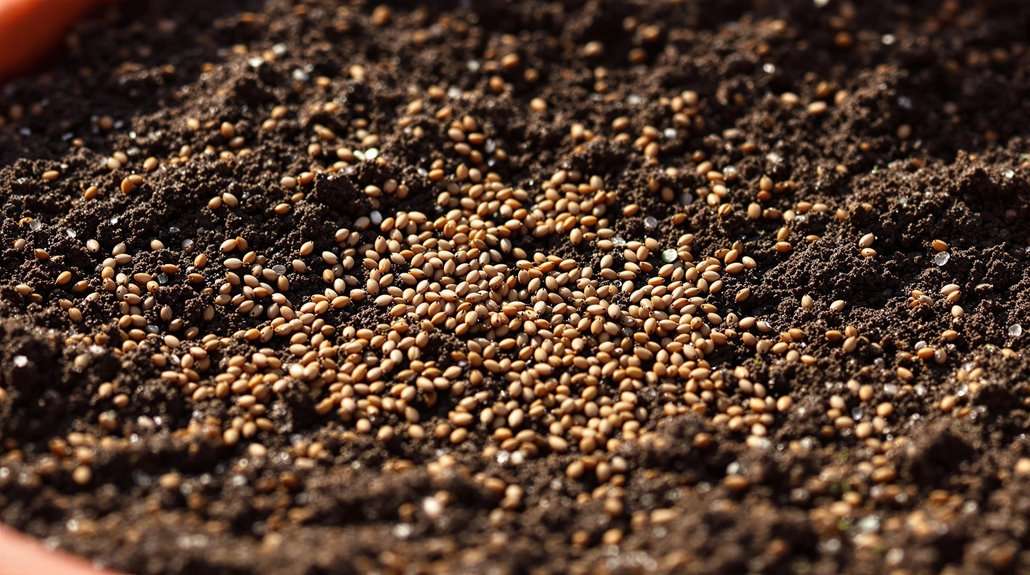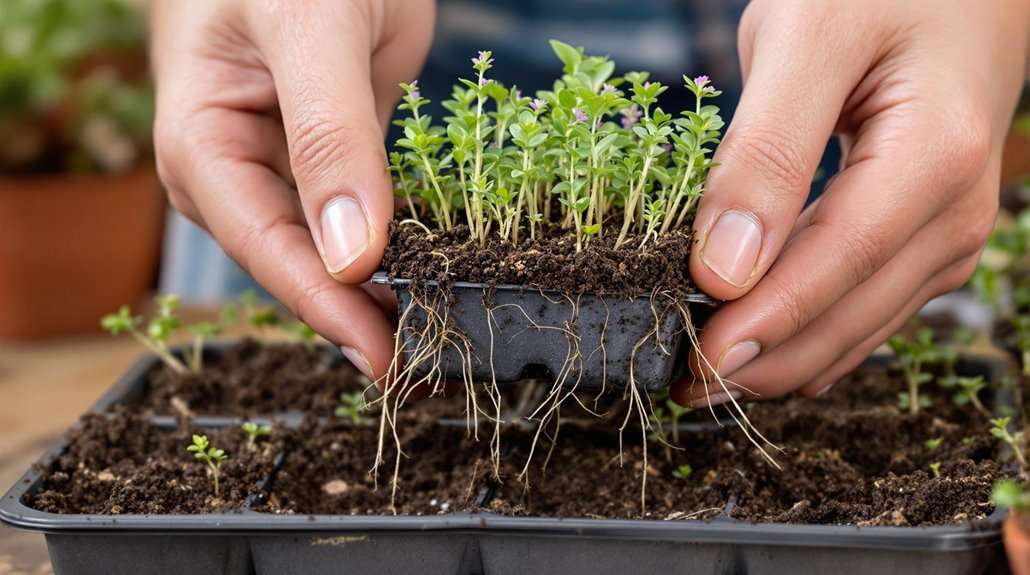How to Grow Thyme From Seed
To grow thyme from seed, you'll need to start with fresh seeds and well-draining soil mix about 8-10 weeks before the last frost. Sprinkle the seeds thinly on the soil surface, press them down gently, and maintain temperatures around 70°F (21°C). Keep the soil consistently moist but not waterlogged, and guarantee the seeds receive plenty of light during germination, which takes 14-28 days. Once seedlings reach 2-3 inches tall with true leaves, transplant them 6-12 inches apart in a sunny location with neutral to alkaline soil. With proper care and patience, you'll discover there's much more to maximizing your thyme growing success.
This post may contain affiliate links. If you make a purchase through these links, I may earn a commission at no additional cost to you. Additionally, portions of this post may be generated using artificial intelligence (AI) technology. While we strive for accuracy, please be aware that AI-generated content may not always be perfect and should be fact-checked when necessary.
The Spatula Scoops
- Sow thyme seeds on the soil surface with sand, press down gently, and keep them exposed to light for germination.
- Maintain consistent temperatures around 70°F (21°C) and provide 6 hours of direct sunlight daily.
- Keep soil consistently moist but not waterlogged, using bottom watering techniques to prevent disturbing seeds.
- Start seeds indoors 8-10 weeks before last frost in well-draining soil with pH between 6.0-7.0.
- Transplant seedlings outdoors when they reach 2-3 inches tall, spacing them 6-12 inches apart.
Getting Started With Thyme Seeds

Before starting your thyme-growing journey, you'll need to understand the basic requirements for successful seed germination. Thyme seeds require 14 to 28 days to germinate and need specific conditions, including consistent temperatures around 70°F (21°C) and exposure to light during the germination process. Using high-quality, eco-friendly cleaning materials like organic cotton materials can also promote sustainable living practices in your garden.
To begin, prepare your growing area with a high-quality seed starting mix, guaranteeing it's evenly moistened but not waterlogged. Since thyme seeds are incredibly tiny, you'll want to sow them generously on the surface of your growing medium. Don't cover the seeds with soil, as they need light to germinate properly. Instead, press them gently into the surface to certify good soil contact. Being a member of the mint family, thyme requires similar care to its aromatic relatives during the early growing stages.
Create a humid environment by covering your seed trays with a clear dome or plastic wrap, but be prepared to remove this cover at the first sign of germination to prevent fungal issues. You'll need to maintain consistent moisture through bottom watering or careful misting, as direct watering can displace these small seeds. Unlike some other herbs, thyme doesn't require pre-soaking, making the initial setup straightforward and uncomplicated.
Selecting The Right Growing Environment
When starting your thyme plants, you'll need a sunny location that receives at least six hours of direct sunlight daily, though a spot with full sun exposure is ideal for developing the strongest flavors and most robust growth. Your growing area should maintain temperatures between 60-70°F (15-21°C) for prime germination and establishment, while offering protection from harsh winds and excessive moisture. Whether you're growing in containers or garden beds, guarantee your chosen spot has excellent drainage and enough space to maintain 6-12 inches between plants, allowing for proper air circulation and future growth. A soil pH that is neutral to slightly alkaline will provide optimal growing conditions for your thyme plants. Additionally, using the right-sized baking sheet, such as a half sheet pan, can help with meal prep and planning, freeing up time to focus on nurturing your thyme plants.
Location And Light Needs
The success of your thyme garden hinges on selecting an ideal growing environment with proper lighting conditions. If you're starting indoors, position your seedlings under grow lights for 12-14 hours daily, keeping the lights just 2 inches above the plants to prevent leggy growth. For outdoor planting, choose a location that receives 6-8 hours of direct sunlight, as this is vital for developing robust plants with concentrated essential oils. Short varieties work best when planted between patio stones or walkways.
Your planting site should feature well-drained, sandy or rocky soil with a neutral to slightly alkaline pH. Before planting, you'll need to clear the area of weeds and incorporate organic compost to improve drainage and nutrient content. If you're starting seeds indoors, begin 8-10 weeks before your region's last frost date, using shallow seed trays or cell packs. When soil temperatures consistently reach 55°F, you can direct sow outdoors or transplant your indoor seedlings after proper hardening off. Space your plants 6-8 inches apart to guarantee adequate air circulation and room for growth, and avoid areas with heavy clay soil or excessive shade, as these conditions can compromise your thyme's development.
Optimal Temperature Range
Creating an ideal temperature environment builds upon proper light and location selection for your thyme seeds. You'll want to maintain a consistent temperature between 60-70°F (15-21°C), with 70°F (21°C) being the sweet spot for peak germination rates. Using a heat mat or selecting a naturally warm location in your home can help maintain these ideal conditions.
Remember that thyme seeds typically take 14-28 days to germinate at optimal temperatures.
To guarantee successful germination of your thyme seeds, follow these essential temperature guidelines:
- Monitor the growing area temperature consistently, keeping it as close to 70°F as possible
- Use a seedling heat mat if your space tends to run cool
- Avoid areas with temperature fluctuations, such as near drafty windows or heating vents
- Wait until outdoor temperatures remain steadily above 65°F before transplanting
When starting thyme seeds indoors, you'll need to be particularly mindful of maintaining stable conditions. Temperature fluctuations can markedly impact germination success, so it's vital to choose a location where you can control the environment. If you're planning to direct sow outdoors, wait until late spring when soil temperatures have warmed consistently and the risk of cold snaps has passed.
Sowing Your Thyme Seeds

Getting Started Right
Starting thyme from seed requires careful attention to timing and temperature for ideal results. You'll want to begin your seeds indoors during spring when temperatures hover around 13°C, using propagator trays with clear plastic lids to create the perfect microclimate for germination. Since thyme is a drought-tolerant plant, it's important to establish strong roots early during the seedling stage.
To guarantee successful seed starting, follow these essential steps:
- Press down your compost firmly in the propagator tray to eliminate air pockets
- Sprinkle seeds evenly across the surface of the compost
- Cover seeds with a thin layer of additional compost
- Press down gently to confirm good seed-to-soil contact
Your seeds will need consistent warmth and moisture during the 14-21 day germination period, maintaining temperatures between 18-21°C. Once your seedlings develop two sets of true leaves, you'll need to carefully transplant them into individual pots or modules, handling them by their leaves to protect delicate stems.
For the best results, keep your young plants in a bright, warm location and water them regularly. When the threat of frost has passed and soil temperatures have warmed, you can move your thyme seedlings to their permanent outdoor home, spacing them 15 centimeters apart in well-draining soil.
Soil and Temperature Essentials
The perfect foundation for growing thyme starts with the right soil and temperature conditions. You'll want to create a well-draining environment by mixing organic compost with garden soil, ensuring your thyme seeds have the nutrients they need for successful germination. If you're container gardening, opt for a specialized herb or vegetable compost to give your plants the best start. Since thyme is slow to grow, starting seeds indoors in late winter gives plants the longest possible growing season.
| Condition | Ideal Range | Warning Signs | Action Required |
|---|---|---|---|
| Soil pH | Neutral to alkaline | Yellowing leaves | Add compost to adjust |
| Temperature | 60-70°F (15-21°C) | Slow growth | Use heat mat |
| Moisture | Consistently damp | Dry or soggy soil | Adjust watering |
| Depth | Surface to 3mm | Poor germination | Replant correctly |
Your thyme seeds will germinate best when soil temperatures hover around 70°F (21°C), though they can still sprout at temperatures as low as 55°F (13°C). Keep in mind that consistently high temperatures above 70°F can hinder germination just as much as cold conditions. You'll achieve the best results by maintaining even moisture levels and using a fine, lightweight starting medium that won't smother your delicate seeds.
Proper Watering Techniques
Proper watering techniques can make or break your thyme seedlings' success. You'll need to maintain consistent moisture without oversaturating the soil, as thyme seedlings are particularly sensitive to both overwatering and underwatering during their early stages of growth.
- Moisten your seed starting mix before sowing to guarantee even moisture distribution
- Use bottom watering techniques to prevent disturbing delicate seedlings
- Mist the surface lightly when needed, avoiding water pooling
- Check soil moisture daily by inserting your finger into the growing medium
Once your seedlings have germinated, you'll want to maintain proper moisture levels while preventing fungal issues. Bottom watering remains your best approach, as it encourages strong root development while keeping leaves dry. When you notice the soil surface feeling slightly dry to the touch, it's time to water again. Regular cleaning and maintenance of your pillow can also help prevent allergens and bacteria from spreading.
As your thyme plants mature, you can gradually reduce watering frequency. You'll want to adjust your watering schedule based on seasonal changes and your plants' growth stage, always verifying good air circulation to prevent moisture-related problems.
Transplanting Young Seedlings

Successfully transplanting young thyme seedlings requires careful timing and preparation to certify their survival. You'll want to start your seeds indoors 8-10 weeks before the last frost date, keeping in mind that germination can take anywhere from 1-12 weeks. Wait until your seedlings have developed their true leaves and reached 2-3 inches in height before considering transplantation. To ensure optimal growth conditions, choose a location that receives full sun exposure. When cooking with thyme, it's essential to have a good grill pan to achieve perfect searing and even heat distribution. Before moving your seedlings to their permanent outdoor home, you'll need to harden them off for 1-2 weeks. Start by placing them in a shaded outdoor spot for a few hours daily, gradually increasing their exposure to sun and wind. During this time, watch for any signs of stress and avoid exposing them to extreme heat. When you're ready to transplant, dig holes twice the width and depth of each root ball. Gently loosen the roots and place each seedling at the same depth it grew in its pot, spacing them 6-12 inches apart. After transplanting, water thoroughly and add a light layer of mulch. You'll need to maintain well-drained soil and confirm good air circulation to prevent disease.
Caring For Growing Plants
Growing healthy thyme plants requires attention to four key factors: light exposure, water management, soil conditions, and spacing. You'll need to provide your plants with plenty of sunlight or grow lights positioned about 2 inches above the seedlings, while ensuring good air circulation to prevent fungal issues. After several years, the center becomes woody and may need careful pruning to maintain plant health. Accurate measurement of ingredients in gardening recipes, such as those using thyme, is crucial, and using dry measuring cups for solid ingredients ensures precision.
When it comes to watering your thyme plants, follow these essential guidelines:
- Check soil moisture daily, watering only when the top few inches feel dry
- Water deeply to reach 6 inches below the surface
- Avoid overwatering, especially during winter months
- Use bottom watering techniques for seedlings to prevent damping off
Your thyme plants don't need much fertilizer, and they actually prefer less fertile soil. If you're using regular potting mix without added nutrients, you can apply a half-strength liquid fertilizer weekly starting at two weeks old. Space your plants 6-12 inches apart to allow proper growth, as they'll spread about a foot wide. While mulching can help retain moisture in hot climates, it's unnecessary in shadier locations. Keep an eye out for weeds and remove them promptly to prevent competition for resources.
Common Problems And Solutions

Even with careful attention to basic care, you'll likely face some challenges when growing thyme from seed. Poor germination rates are common, but you can overcome this by overseeding and maintaining consistent moisture levels. Using a heating mat and providing adequate light will substantially improve your success rate. Coarse sand and peat can create an ideal growing medium for thyme seeds. Many herbs, including thyme, require well-drained soil to thrive.
You'll need to carefully manage moisture levels, as thyme seeds require consistent dampness without becoming waterlogged. Using a spray bottle for watering and adding a light layer of vermiculite can help maintain this balance. Don't bury the seeds deeply, as they need light to germinate.
When it's time to transplant, wait until your seedlings reach about 4 inches in height. You'll want to space them 9 inches apart in your garden or 12-18 inches if you're planning for field production. Remember that thyme grows slowly at first, so don't rush to transfer them to larger containers until they've truly outgrown their current space.
| Problem | Solution |
|---|---|
| Poor Germination | Overseed and use heating mat |
| Moisture Issues | Use vermiculite and humidity dome |
| Light Requirements | Place 2" below grow lights |
| Slow Growth | Start 8-10 weeks before last frost
Harvesting Your Thyme Crop
Three key factors determine the perfect time to harvest your thyme: plant height, leaf quality, and time of day. You'll want to wait until your plants reach at least 6 inches tall and show vibrant, aromatic leaves. For the best results, harvest in the morning after the dew has dried but before the day's heat sets in. Additionally, a diet rich in calcium, like that provided by bone broth, can support healthy plant growth and development.
To maintain a healthy, productive thyme plant, follow these essential harvesting practices:
- Cut stems just above a leaf node using clean, sharp scissors
- Remove flower buds as soon as they appear to promote leaf growth
- Harvest only the top sets of leaves to encourage branching
- Never pull or tear stems, as this can damage the plant's roots
After harvesting, give your thyme plants some attention to guarantee continued growth. Water them thoroughly, especially during dry periods, but don't fertilize – thyme actually prefers poor soil conditions. Regular pruning will keep your plants bushy and prevent them from becoming woody. If you live in a region with harsh winters, you'll need to provide protection to guarantee year-round harvesting capability.
Frequently Asked Questions
Can Thyme Seeds Survive Frost if Accidentally Planted Too Early?
You're taking a significant risk if your thyme seeds encounter frost. While mature thyme plants are frost-hardy, seeds and young seedlings aren't as resilient. Your best chance at salvaging accidentally frost-exposed seeds is to protect them immediately with row covers or cloches. However, you'll likely need to replant, as frost damage typically prevents germination or kills emerging sprouts. For success, wait until soil temperatures reach 65°F.
Does Artificial Grow Light Affect the Flavor of Thyme Leaves?
While artificial grow lights don't directly impact thyme's flavor, they can influence the plant's chemical composition. You'll find that natural sunlight typically produces the best flavor profile, but high-quality grow lights can effectively mimic these conditions. If you're using artificial lighting, focus on maintaining consistent light exposure and ideal growing conditions, as the overall environment contributes more substantially to your thyme's taste than the light source alone.
Will Thyme Cross-Pollinate With Other Herb Varieties in My Garden?
Birds of a feather flock together, and the same goes for herb pollination – but you don't need to worry about your thyme crossing with other herbs like basil or mint. Thyme will only cross-pollinate with other thyme varieties within the Thymus genus. If you're growing multiple thyme varieties and want to keep them pure, you'll need to space them several feet apart or use physical barriers like cages or bags during flowering.
How Many Years Can a Thyme Plant Produce Viable Seeds?
Your thyme plant can produce viable seeds for 4-6 years under ideal conditions. You'll see peak seed production during the second and third years, when the plant's fully mature. After that, seed viability gradually declines as the plant becomes woody. With proper care, including regular pruning and maintaining well-drained soil, you can extend this productive period by encouraging new growth and preventing die-back.
Can I Grow Thyme Indoors Year-Round Without Supplemental Lighting?
Properly producing potent thyme plants indoors without supplemental lighting is challenging. You'll need to place your plants near a south-facing window that receives at least 6 hours of direct sunlight daily. If you can't provide sufficient natural light, your thyme will likely become leggy and produce fewer leaves. For the healthiest year-round growth, you'll want to combine natural light with grow lights, especially during shorter winter days.





